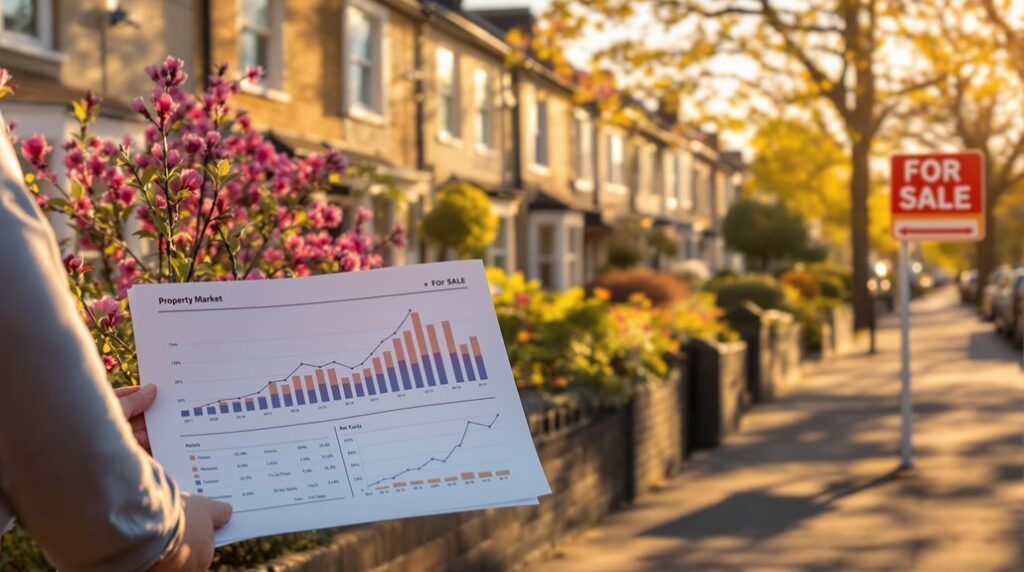I’ve spent the last decade analyzing UK property data, and I can tell you that most investors are getting their timing completely wrong. They’re buying at peaks and selling during corrections, fundamentally doing the opposite of what the numbers suggest. The 18-year property cycle isn’t just theory—it’s a predictable pattern that’s played out consistently since the 1950s. Right now, we’re positioned at a critical juncture that could determine your returns for the next five years.
Key Takeaways
- Buy during correction phases when properties are 10-15% below peak valuations and interest rates are falling or stabilizing.
- Sell when annual growth rates hit 3%-6.4% and your property has gained over £100k in five years.
- Target northern regions like Birmingham and Manchester for purchases, avoiding southern areas with subdued growth potential.
- Time purchases with Bank of England rate cuts and improved mortgage affordability below 5% rates.
- Focus on terraced houses and semi-detached properties over flats, as they show stronger 4.5% growth potential.
Understanding the Four Phases of UK Property Market Cycles
While many investors view property markets as unpredictable, the UK property cycle actually follows recognizable patterns that I’ve observed repeat consistently over decades. Through empirical analysis, I’ve identified four distinct phases that define these cycles.
The downturn begins when markets peak and prices start declining. Demand weakens as economic conditions worsen, investor confidence wanes, and external factors like rising interest rates trigger the shift.
The slump represents the cycle’s bottom, where prices have fallen considerably, demand remains very low, construction activity halts, and economic conditions are poor with high unemployment. This phase creates active rental markets as homeownership becomes less accessible.
Recovery emerges as prices start rising again, demand increases, economic conditions improve, banks resume lending, and experienced investors begin buying.
The boom completes the cycle with rapid price growth and peak market activity.
The 18-Year Property Cycle: A Complete Framework for Investors
These four phases occur within a broader pattern that I’ve found invaluable for strategic investment decisions: the 18-year property cycle. Land economist Fred Harrison identified this framework, accurately predicting the UK’s 1990 and 2008 crashes using 300 years of historical data. Understanding local market dynamics is crucial for investors to effectively navigate these cycles.
The cycle consists of recovery (6-7 years), boom (6-7 years), and bust (4 years). A mid-cycle dip often interrupts growth, while the final two boom years create the “Winner’s Curse” – unsustainable price peaks. However, the post-2022 price drop of 3% nominally translates to a 15% real-term drop when adjusted for inflation.
Based on the 2008 crash, Harrison projects the next bust around 2026, placing us currently in the late boom phase. While skeptics cite unprecedented factors like quantitative easing, I use this framework to time my entries during recovery and exits before the bust hits.
Where We Stand in 2025: Current Market Position and Opportunities

As we move deeper into 2025, the UK property market displays clear signs of being in the late boom phase of the 18-year cycle, with annual house price growth at 3.7% pushing average values to £294,818. I’m seeing distinct regional divergence – northern regions like the North West and North East are forecast to achieve 5% growth, while southern areas lag at 2.5%. This creates compelling opportunities for strategic investors.
The property type hierarchy has shifted dramatically. Terraced houses lead with 4.5% growth, while flats show weakness at 3.2%. The first-time buyer market has rebounded significantly, with a fifth more entering the market last year as improved mortgage affordability opens new opportunities. This is particularly relevant as average house prices continue to fluctuate, creating attractive entry points for new buyers. Easing interest rates and improved mortgage affordability are driving demand, particularly in northern regions where affordability pressures are lower. For those positioning themselves correctly, semi-detached properties offer balanced risk-reward with 2.5% growth potential.
Price Forecasts and Growth Drivers for 2025-2027
Looking ahead through 2027, the forecasting landscape reveals a compelling acceleration story that I’m tracking closely across multiple expert predictions. We’re seeing consensus growth projections of 2%-4% in 2025, climbing to 3%-5.5% by 2027. Knight Frank forecasts 3.5% growth in 2025, while Savills predicts 4% rising to 5.5% in 2026.
The OBR takes a more conservative stance with 1.1% growth in 2025, but even they see acceleration to 2.7% by 2027. What’s driving this momentum? Interest rate cuts are the critical catalyst I’m watching. As mortgage rates gradually fall through 2027, affordability pressures will ease. The persistent housing shortage underpins this growth trajectory, despite regional disparities favoring northern markets over southern England’s constrained 2.5% growth. Additionally, home renovation costs have a significant impact on property value, influencing buyer decisions and market dynamics.
Buyer sentiment remains cautiously optimistic, with 45% of UK adults expecting house prices to rise in 2025, while only 10% anticipate a decline.
Market Performance Indicators Signaling Recovery Phase

The data I’m analyzing reveals clear recovery signals across every major market performance metric. You’re seeing 3.5% year-on-year price growth coupled with 0.0% month-on-month stability—that’s the sweet spot indicating sustainable momentum without overheating. Transaction volumes have normalized at 1.1 million completions annually, while mortgage approvals are rebounding from April’s temporary slowdown.
What excites me most is the 42-day average time on market, proving efficient buyer-seller matching. First-time buyers now represent 34% of purchases, injecting fresh demand into the system. With interest rates stabilized in the 4-5% range and wage growth outpacing inflation, affordability pressures are easing. The 3.8% unemployment rate sustains this buyer influx, while regulatory flexibility has enabled over 3,000 additional mortgage approvals. Moreover, sellers should be aware of hidden costs associated with the selling process, which can affect overall profit margins. The strong sale-to-asking price ratio of 96.2% demonstrates confident buyer sentiment and reduced negotiation pressure on sellers. These indicators collectively confirm we’re in a genuine recovery phase.
Optimal Timing Strategies for Property Purchases
While recovery signals dominate today’s headlines, I’ve learned that successful property investment hinges on strategic timing rather than market momentum alone. I target correction phases where prices have dropped 10-15% below peak valuations, focusing on properties with extended listing durations and motivated sellers. I monitor Bank of England rate decisions closely, purchasing when rates trend downward or stabilize after prolonged increases. Regional cycle divergence offers my biggest opportunities—I target commuter belts and secondary cities experiencing delayed growth cycles while avoiding markets with over 7% annual price inflation. Additionally, I recognize that properties at risk of subsidence issues may require structural surveys, which can significantly impact investment costs. I coordinate purchases with improving GDP growth and falling unemployment, particularly targeting distressed sales when transaction volumes plummet and amateur investors exit. Understanding the UK housing market’s predictable pattern of growth, stability, correction, and recovery allows me to position investments during correction phases when falling prices create the strongest opportunities for value acquisition.
Prime Buying Opportunities During Correction and Recovery Phases
Although market corrections often trigger panic among retail investors, I’ve discovered these downturns create the most lucrative buying opportunities for disciplined property investors. During correction phases, I target undervalued properties in resilient locations while securing distressed assets at significant discounts. The reduced competition allows me to negotiate below asking prices and conduct thorough due diligence. Additionally, I ensure to account for allowable expenses that can further reduce my taxable gains when selling properties.
When recovery indicators emerge—gradual price increases, rising institutional activity, and improving lender criteria—I shift focus to off-market deals in emerging neighborhoods. I prioritize commercial assets anticipating business growth and target regeneration zones with planned infrastructure developments. During this phase, experienced investors typically dominate the market as amateur investors continue selling off properties from previous downturns.
My cross-phase strategy balances correction acquisitions with recovery refinancing, allocating 70% to long-term holds while maintaining liquidity reserves. This disciplined approach consistently delivers superior returns across market cycles.
Strategic Selling: Maximizing Returns During Boom Periods
When property prices surge beyond sustainable thresholds, I’ve learned that timing your exit becomes more critical than the entry strategy itself. I monitor annual growth rates exceeding 3%-6.4% as clear peak signals, particularly when multiple indices confirm this momentum. The recent £294,818 average surpassing 2022 peaks presented an ideal exit opportunity. Additionally, understanding local market conditions can provide further insights into the best timing for selling.
I prioritize selling detached homes that’ve gained £100k+ over five years, capitalizing on terraced houses leading growth at 4.5% annually. Transaction surges like March 2025’s +89.7% spike create maximum buyer competition before policy changes hit.
I avoid post-policy lulls where urgency collapses, instead targeting high-activity phases with 395,090+ transactions quarterly. During interest-rate easing cycles, I align sales with improved mortgage affordability while economic catalysts drive consistent 4-5.5% projected growth. Regional variations present additional opportunities, with the North West showing exceptional momentum at 5.89% year-on-year growth compared to more subdued southern markets.
Sector-Specific Investment Approaches for Maximum Returns

Five distinct property sectors dominate the UK’s investment landscape, each requiring tailored strategies that capitalize on unique market dynamics and risk profiles.
I’ve identified regional residential markets as your strongest entry point. Birmingham’s £232,000 average property price sits well below the national £282,000, while Manchester and Birmingham forecast 16% growth through 2028. Durham delivers yields exceeding 7%, considerably outperforming London.
Commercial offices present compelling opportunities with prime rental growth forecast across all markets for 2025. Foreign investment’s returning to Central London as liquidity improves.
Industrial and logistics properties offer stability with consistent occupier demand and moderate rental growth expected. Purpose-built rentals, particularly student housing, guarantee consistent returns through expanding university sectors.
Data centres represent specialist opportunities, though London’s new supply will exceed take-up, creating selective investment windows. Properties within 500m of transport stations command a 9.7% premium, making proximity to connectivity hubs a critical factor in acquisition decisions.
Leveraging Interest Rates and Government Policies for Profit Optimization
Strategic positioning around interest rate movements and government policy shifts creates the most significant profit opportunities in UK property investment. I’ve tracked the Bank of England’s recent cut to 4.25% in May 2025, with economists projecting further drops to 3.75% by year-end. This creates a narrowing window for ideal positioning. Conducting a thorough level 1 survey can help you identify potential issues, ensuring you make the most of your investment.
Mortgage rates between 4-5% represent a shift from historic lows, yet they’re driving renewed affordability for buyers. I’m seeing 3.5% annual house price growth nationally, with wages rising 5.6% ahead of inflation – that’s prime buying territory. The North-South divide is creating distinct regional opportunities, with northern regions experiencing robust growth while London and the South East see subdued activity.
The key insight? Government disinflation policies are working, giving the BoE room to cut rates further. I’m positioning for this trend by securing financing now before rates potentially reverse, maximizing leverage while borrowing costs remain manageable.
Conclusion
I’ve shown you the data-driven framework for timing your UK property investments strategically. You’ll maximize profits by buying during correction phases when prices drop 10-15% below peak, then selling when annual growth hits 3-6.4%. I recommend monitoring interest rate cycles and targeting commuter belts for delayed growth opportunities. The 18-year cycle pattern doesn’t guarantee outcomes, but it’s proven reliable for informed investors who act decisively on market signals.
References
- https://jamesanderson.co.uk/news/understanding-uk-property-market-cycles-when-is-the-right-time-to-buy
- https://www.propertyinvestmentsuk.co.uk/18-year-property-cycle/
- https://hoa.org.uk/advice/guides-for-homeowners/i-am-buying/house-price-forecast/
- https://www.aberdeeninvestments.com/en-gb/intermediary/insights-and-research/uk-real-estate-market-outlook-q2-2025
- https://lifestylepropertygroup.co.uk/the-18-year-property-cycle/
- https://ehcapital.uk/understanding-the-uk-housing-market-cycle/
- https://evo-pm.com/insights/how-to-use-the-18-year-property-cycle-to-your-advantage/
- https://researchportal.northumbria.ac.uk/files/28744749/Housing_cycles_in_the_UK_a_historical_and_empirical_investigation.pdf
- https://www.gradragstoriches.co.uk/post/the-18-year-property-cycle-is-broken
- https://www.youtube.com/watch?v=LpoLxdV-648

